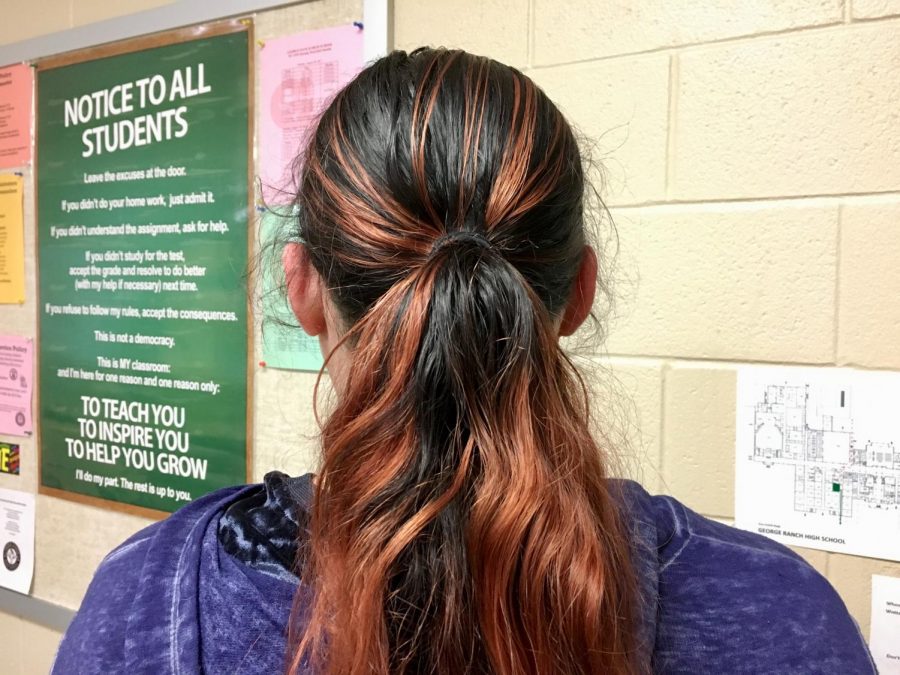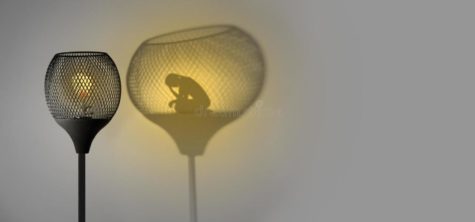The Effects of Hair Dye
What hair dye can truly do to hair.
A student with dyed hair.
March 19, 2018
“Yeah right!” was the response I used to get in middle school when I swore that I had never colored my hair. Maybe it was hard for people to believe that my hair is so much lighter at the tips than it is at the roots, but I have never touched it with any kind of dye. I later realized, however, that several people in my grade have colored their hair, to the point where it has become normal, and lighter tips was a trend that was in at the time. When that trend passed, several girls got fades, and then eventually highlights. Now, girls at George Ranch are completely changing their hair color. Though they may find it pretty (and it definitely can be!), hair dye comes with a set of risks that every teenage girl should know about.
Hair is naturally colored by a particle called Melanin. Melanin also colors human skin, because the color Melanin a person receives is determined by genetics. As people age, Melanin in hair particles may begin to turn gray, which is when many women consider buying a box of dye to hide their white strands. Another reason a woman or girl may color her hair is that she wants a change from the same old thing. Whatever the reason may be, or whichever dye or color is chosen, they all work the same. Hair dye contains an ingredient called ammonia, which opens up the parts of hair that contain color. The colored ammonia enters, where it colors over the Melanin. After the dye sits for a few minutes, the hair is rinsed and the dye stays in.
Ammonia may be an effective way to color hair, but it definitely isn’t healthy for the hair. Once the melanin capsules contain ammonia, it’s almost as if they burn out, or get fried. Their hydration and fullness partially disappear, leaving the hair itself to suffer. A person who has dyed their hair will normally notice that it may become dry or frizzy. Brittleness and hair loss are also extremely common side effects after dyeing hair several times.
Dyeing one time to hide gray is different than dyeing the hair over and over again. When a fresh coat of dye is painted onto strands of hair, the old coat is still present underneath. After several coats, the amount of ammonia becomes almost unbearable for the hair, and the side effects will really begin to kick in. Some people, however, continue to color their hair because it can become an addiction.
When a line begins to form below the roots due to growth, or the dye begins to get old and fade, the easiest thing for a person to do is to have their hair dyed again. After so many times of dyeing, the effects kick in, leaving people with the desire to use using curling irons, straightening irons, and chemical products to make their hair look smooth and hydrated again. All of these things cause more damage, though. Undoing all of this damage could take years if it can be undone at all.
Sara Walker, a senior, has colored her hair before. She decided that she wanted a lighter, brighter blonde than her natural tone. “There was no damage [the first time]” she said. “I thought it was fun and I kept doing it because I liked the color. [After] I dyed it more than once, the damage was permanent.” Walker claims that the damage done still affects her today, even though she no longer has any dye in her hair.
[After] I dyed it more than once, the damage was permanent
— Sara Walker
Two Freshman, Sadaka Arastu and Holly Smith, have not colored their hair but they both plan to very soon. They, however, have decided that the risks aren’t worth ruining their hair and are not going to dye the roots, but instead just dye from the shoulders down. “I think the risks are only a big deal if you dye the roots,” Arastu said. Smith also has a similar view. “I’m gonna do it so that it’s easy to cut off. I’m not dying the roots.” Both girls agree that if the hair dye becomes a problem, they can just settle for a shorter cut.
Hair dye has positives, such as covering up gray and allowing girls to have fun trying different things. It also allows actors and actresses to become more in tune with the characters that they portray. It does, however, come with many risks. Before a teenager decides to dye her hair, she may consider trying temporary dye first or possibly just dyeing from the chin or shoulders down. Many have found that a color change hasn’t been worth the damage they faced later.
New Cancer Research also shows that many cases of non-Hodgkin’s Lymphoma have been linked to the frequent use of hair dye. Not only can ammonia become too strong for the hair to withstand, but it can spread to the body and cause the formation of cancerous lymph nodes as well. Many patients have claimed that their hair and was highly damaged by dye before they lost it all to treatment.
Hair dye clearly does have positives, but the negatives can easily outweigh them if one is not careful before deciding to change the color of their hair. It may be best to try temporary dye or change the cut first rather than using permanent dye immediately. Teenagers may also want to consider not coloring the roots of their hair, just in case the dye needs to be cut off. Fading into the color may also be safer so that hair doesn’t have to be re-dyed over and over. Whatever the reason may be for coloring hair, caution should always be taken before making the decision, especially since the damage may never be able to be undone.













